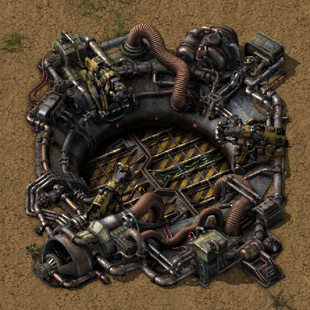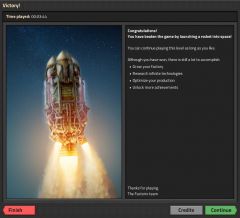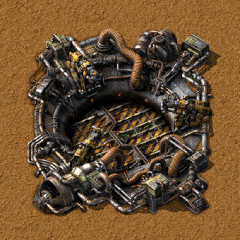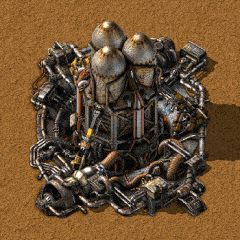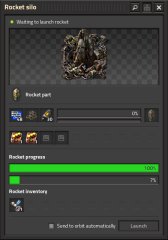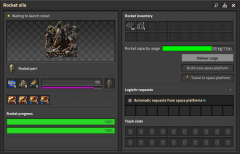Rocket silo: Difference between revisions
HeliGungir (talk | contribs) →Navbar: Changed {{ProdutionNav}} to {{SpaceNav}} |
|||
| (18 intermediate revisions by 11 users not shown) | |||
| Line 1: | Line 1: | ||
{{languages}} | {{languages}} | ||
{{:Infobox:Rocket silo}} | {{:Infobox:Rocket silo}} | ||
The '''rocket silo''' is an important production building that serves as the sole win condition and a source of [[space science pack]]s in the base game. In [[Space Age]]{{SA}}, it is instead the only way to launch items and the player off [[Nauvis]] to orbiting space platforms to visit the neighboring planets of [[Vulcanus]]{{SA}}, [[Fulgora]]{{SA}}, [[Gleba]]{{SA}}, and [[Aquilo]]{{SA}}. | |||
The ''' | |||
Building a silo requires, among other things, [[electric engine unit]]s, [[processing unit]]s, and [[concrete]], which all must be produced in [[assembling machine]]s or [[foundry|foundries]] and cannot be crafted by hand from raw materials. The rocket itself can only be produced in the silo. | |||
Once the silo has been built and placed it can be filled with [[processing unit]]s, [[low density structure]], and [[rocket fuel]], which will create [[rocket part]]s within the silo. 100 rocket parts are needed to construct a rocket (50 parts in Space Age{{SA}}). The silo accepts [[productivity module]]s, and due to the high resource cost of rockets, silos are a prime candidate for their use. Once constructed, the rocket will rise into position and can be launched. It is required to place a cargo landing pad somewhere on the planet in order to launch a rocket. | |||
Once a rocket has been constructed, the silo will continue to craft a second rocket within the silo. If both are constructed, once the first rocket has been launched, the second will rise into place without the silo going through its normal animation of closing and reopening its doors. This is particularly useful in Space Age when crafting speeds are faster and rockets are in increased demand. | |||
== Base game == | |||
The rocket silo is unlocked with its [[rocket silo (research)|respective technology]] using all [[science pack]]s except for military. It requires 10 low density structure, rocket fuel, and processing units to make 1 [[rocket part]], for a total of 1,000 of each for a single rocket. | |||
Before a rocket can be launched, the player must place a [[cargo landing pad]] somewhere on the planet. The landing pad can be anywhere on the planet, with no restrictions on distance from the silo, but only one can be placed. | |||
Launching a rocket requires a payload and launching one for the first time will trigger the victory screen, which thanks the player for playing and invites them to keep growing their factory, with the options of exiting the game, viewing the credits, or continuing the game. The rocket can be launched manually by clicking the "Launch" button. Checking the "Send to orbit automatically" checkbox will make the rocket launch automatically once it has a payload. | |||
Only two items can be used as a payload. The first is a [[satellite]]; launching a rocket with one of these will return a shipment of 1,000 [[space science pack]]s to the cargo landing pad roughly 29 seconds after the launch is triggered. The second is a... | |||
{{Spoiler|button-text=Spoiler! Click to view.|message= | |||
<li>[[Raw fish]]: Grants the "So long and thanks for all the fish!" achievement. Other than this, it also wastes the launch.</li> | |||
}} | |||
== Space Age == | |||
{{About/Space age}} | |||
=== Basics === | |||
In Space Age, the silo is unlocked far earlier in the game, requiring 1,000 of only [[automation science pack|automation]], [[logistic science pack|logistics]] and [[chemical science pack|chemical]] science packs. The silo is a critical building for transporting items and the player offplanet to orbiting [[space platform]]s. Rockets are built identically to the base game, except that a single rocket part takes only 1 of each material instead of 10 and only 50 rocket parts are required per rocket. This means that a single rocket requires only 50 of each resource. The silo greatly benefits from higher [[quality]] productivity modules as well as the [[technologies#Infinite Research Exclusive to Space Age|rocket part productivity]] infinite technology, both of which can reduce the cost of rockets even further. | |||
The rocket can be manually launched in one of three ways: | |||
* Deliver cargo: launch with a payload of any size or composition at any orbiting platform | |||
* New platform: if the silo contains exactly one [[space platform starter pack]], clicking this will open the map and invite the player to enter a name for the new platform. | |||
* Travel to platform: the rocket will launch to any orbiting platform with the player as its sole payload. The player can bring any equipped [[armor]], their installed modules, and any weapons, but no ammo for those weapons. | |||
[[File:rocket_silo_gui.png|The rocket silo's GUI in Space Age|310px|right]] | |||
=== Rocket capacity === | |||
Unlike in the base game, a space age rocket can accept nearly every item in the game as a payload. This is expressed by the silo as a weight limit. Every item in the game has a rocket capacity which is the maximum number of items that can fit in a single rocket. An item's rocket capacity can be read by the circuit network by feeding an item into the [[selector combinator]] and choosing the respective mode of operation. As a general rule of thumb, the more complex the item, the fewer can fit within a rocket. | |||
Some items, like the rocket silo itself and the [[atomic bomb]], are too heavy for rockets, and so the raw materials must be shipped to orbit individually and assembled on the destination planet. | |||
[[Fluids]] cannot be put in rockets, but full [[barrel]]s can. Some fluids cannot be barreled, so they cannot be transported by rocket. This is notably the case for all the fluids that can only be obtained on [[Fulgora]] and [[Aquilo]], except for [[fluoroketone]]. | |||
=== Orbital requests === | |||
The rocket silo can detect requests from any space platform in orbit around the current planet. These can be satisfied in two ways. | |||
* If "Automatic requests from space platforms" is ''not'' selected, the silo acts as a large container. Items can be inserted and removed with [[inserters]]. If the silo receives a full rocket of a single item that is requested, the rocket will automatically launch to the platform requesting that item, even if the payload is more than what is being requested. If multiple platforms are requesting the same item, the rocket will prioritize the earliest platform that the player created. | |||
* If automatic requests ''is'' selected, the silo acts similar to a [[requester chest]]. [[Logistic robot]]s will fill the silo automatically from the [[logistic network]] (including from [[buffer chest]]s), and the rocket will launch automatically when full, unless the requesting platform has set a minimum payload to a lower amount than a full load. If there are items in the rocket inventory when this box is selected, those items will be moved to the silo's trash slots and be removed by logistics robots. | |||
Regardless of option selected, the rocket will only launch automatically when it contains at least one item. | |||
The silo can be connected to the [[circuit network]], with two output functions. | |||
* Output requests: Outputs the sum of requests from all orbiting platforms, if any. A request is considered satisfied and will be removed from the output the instant the rocket launch is triggered, not when the delivery to the platform actually happens. | |||
* Output contents: Outputs the contents of the rocket silo. If automatic requests is selected, this option will do nothing. | |||
== Maximum throughput == | |||
In the base game, a fully moduled silo has +611% crafting speed from beacons and +40% productivity. | |||
Modules accelerate crafting time in the first phase, but have no effect on animations in the other phases. | |||
There are five phases to a rocket launch. | There are five phases to a rocket launch. | ||
| Line 52: | Line 94: | ||
368 ticks, or ~6.133 seconds. | 368 ticks, or ~6.133 seconds. | ||
If a second rocket was buffered within the silo, this step is skipped. | |||
=== Conclusions === | === Conclusions === | ||
| Line 57: | Line 101: | ||
With a build time of 1250 + 14, the delay from animations is 2420 ticks.[https://www.reddit.com/r/technicalfactorio/comments/x92gfa/more_empirical_measurements_on_rocket_silos/] | With a build time of 1250 + 14, the delay from animations is 2420 ticks.[https://www.reddit.com/r/technicalfactorio/comments/x92gfa/more_empirical_measurements_on_rocket_silos/] | ||
=== Space Age === | |||
In Space Age, the rocket silo gained the ability to buffer a second rocket ready to load and launch [https://factorio.com/blog/post/fff-405]. If a second rocket is ready, then the rocket silo skips the door close/open animation. This results in a rocket launch approximately every 27 seconds, with sufficient speed and/or productivity bonuses (enough to get 111 rocket parts per minute). | |||
== Achievements == | == Achievements == | ||
The rocket silo, which is used to win the game, is directly connected to the following game-win-based achievements: | The rocket silo, which is used to win the base game, is directly connected to the following game-win-based achievements: | ||
{{Achievement|smoke-me-a-kipper-i-will-be-back-for-breakfast}} | {{Achievement|smoke-me-a-kipper-i-will-be-back-for-breakfast}} | ||
{{Achievement|no-time-for-chitchat}} | {{Achievement|no-time-for-chitchat}} | ||
| Line 69: | Line 116: | ||
== Trivia == | == Trivia == | ||
Prior to version [[version history/2.0.0#2.0.7|2.0]], the rocket could accept any item as cargo; however, most did nothing in particular and simply wasted the launch. Notable exceptions included: | |||
{{Spoiler|button-text=Spoiler! Click to view.|message= | {{Spoiler|button-text=Spoiler! Click to view.|message= | ||
<ul><li> [[Vehicle]]s : When a vehicle | <ul><li> [[Vehicle]]s : When a vehicle was inserted into the payload slot, the player could enter the rocket like they would any other vehicle, then launch and ride it. | ||
<ul><li> This | <ul><li> This allowed a fast-moving view of one's base (as the game world is internally 2-dimensional, the rocket actually simply moved north along the map), and then returned the player next to the launching silo once the launch animation had finished. | ||
<ul><li> If all space near the rocket silo is occupied, the player is placed at spawn instead.</li> | <ul><li> If all space near the rocket silo is occupied, the player is placed at spawn instead.</li> | ||
<li> | <li> Wasted the launch, as the rocket's sole payload slot is occupied by the vehicle, rather than a satellite. (Having any number of satellites in the car's trunk or the "astronaut"s inventory does not count.)</li></ul></li> | ||
<li>[[Space science pack]]: Returned one [[raw fish]] for every science pack that was launched, but no more than 100 raw fishes per launch.</li></ul>}} | |||
<li>[[Space science pack]]: | |||
== Gallery == | == Gallery == | ||
<gallery widths=240px heights=240px> | <gallery widths=240px heights=240px> | ||
File: | File:Victoryv2.jpg|The victory screen | ||
File: | File:rocket_silo_rising_rocket.gif|The rocket rising and being primed for launch. | ||
File: | File:rocket_silo_launch.gif|The rocket launching. | ||
File: | File:Rocket_silo_gui_base_game.png|The rocket silo's GUI | ||
File:Rocket_silo_gui_space_age.png|The rocket silo's GUI in Space Age | |||
</gallery> | </gallery> | ||
== History == | == History == | ||
{{history|2.0.7| | |||
* Updated sprite for the rocket. A payload is now required to win the game. | |||
* Rocket silos continue producing parts for the next rocket while the current rocket is being launched. Completing another rocket soon enough skips closing and reopening the doors. | |||
* {{SA}} Rocket silo circuit connection can read orbital requests.}} | |||
{{history|0.17.0| | {{history|0.17.0| | ||
| Line 110: | Line 159: | ||
* [[Satellite]] | * [[Satellite]] | ||
{{ | {{SpaceNav}} | ||
{{C|Space related}} | {{C|Space related}} | ||
Latest revision as of 07:28, 9 November 2025
| Rocket silo |
- Base game
- Space Age mod
|
Recipe |
|||||||||||||
| +++++ → | |||||||||||||
|
Total raw |
|||||||||||||
| +++++ | |||||||||||||
|
Map color |
|||||||||||||
|
Health |
|
||||||||||||
|
Resistances |
Fire: 0/60% |
||||||||||||
|
Stack size |
1 |
||||||||||||
|
Too heavy for a rocket! |
|||||||||||||
|
Dimensions |
9×9 |
||||||||||||
|
Energy consumption |
4.0 MW (electric) |
||||||||||||
|
Crafting speed |
|
||||||||||||
|
Mining time |
1 |
||||||||||||
|
Module slots |
4 slots |
||||||||||||
|
Prototype type |
|||||||||||||
|
Internal name |
rocket-silo |
||||||||||||
|
Required technologies |
|||||||||||||
|
Produced by |
|||||||||||||
The rocket silo is an important production building that serves as the sole win condition and a source of space science packs in the base game. In Space Age![]() , it is instead the only way to launch items and the player off Nauvis to orbiting space platforms to visit the neighboring planets of Vulcanus
, it is instead the only way to launch items and the player off Nauvis to orbiting space platforms to visit the neighboring planets of Vulcanus![]() , Fulgora
, Fulgora![]() , Gleba
, Gleba![]() , and Aquilo
, and Aquilo![]() .
.
Building a silo requires, among other things, electric engine units, processing units, and concrete, which all must be produced in assembling machines or foundries and cannot be crafted by hand from raw materials. The rocket itself can only be produced in the silo.
Once the silo has been built and placed it can be filled with processing units, low density structure, and rocket fuel, which will create rocket parts within the silo. 100 rocket parts are needed to construct a rocket (50 parts in Space Age![]() ). The silo accepts productivity modules, and due to the high resource cost of rockets, silos are a prime candidate for their use. Once constructed, the rocket will rise into position and can be launched. It is required to place a cargo landing pad somewhere on the planet in order to launch a rocket.
). The silo accepts productivity modules, and due to the high resource cost of rockets, silos are a prime candidate for their use. Once constructed, the rocket will rise into position and can be launched. It is required to place a cargo landing pad somewhere on the planet in order to launch a rocket.
Once a rocket has been constructed, the silo will continue to craft a second rocket within the silo. If both are constructed, once the first rocket has been launched, the second will rise into place without the silo going through its normal animation of closing and reopening its doors. This is particularly useful in Space Age when crafting speeds are faster and rockets are in increased demand.
Base game
The rocket silo is unlocked with its respective technology using all science packs except for military. It requires 10 low density structure, rocket fuel, and processing units to make 1 rocket part, for a total of 1,000 of each for a single rocket.
Before a rocket can be launched, the player must place a cargo landing pad somewhere on the planet. The landing pad can be anywhere on the planet, with no restrictions on distance from the silo, but only one can be placed.
Launching a rocket requires a payload and launching one for the first time will trigger the victory screen, which thanks the player for playing and invites them to keep growing their factory, with the options of exiting the game, viewing the credits, or continuing the game. The rocket can be launched manually by clicking the "Launch" button. Checking the "Send to orbit automatically" checkbox will make the rocket launch automatically once it has a payload.
Only two items can be used as a payload. The first is a satellite; launching a rocket with one of these will return a shipment of 1,000 space science packs to the cargo landing pad roughly 29 seconds after the launch is triggered. The second is a...
Space Age
![]() Space Age expansion exclusive feature.
Space Age expansion exclusive feature.
Basics
In Space Age, the silo is unlocked far earlier in the game, requiring 1,000 of only automation, logistics and chemical science packs. The silo is a critical building for transporting items and the player offplanet to orbiting space platforms. Rockets are built identically to the base game, except that a single rocket part takes only 1 of each material instead of 10 and only 50 rocket parts are required per rocket. This means that a single rocket requires only 50 of each resource. The silo greatly benefits from higher quality productivity modules as well as the rocket part productivity infinite technology, both of which can reduce the cost of rockets even further.
The rocket can be manually launched in one of three ways:
- Deliver cargo: launch with a payload of any size or composition at any orbiting platform
- New platform: if the silo contains exactly one space platform starter pack, clicking this will open the map and invite the player to enter a name for the new platform.
- Travel to platform: the rocket will launch to any orbiting platform with the player as its sole payload. The player can bring any equipped armor, their installed modules, and any weapons, but no ammo for those weapons.
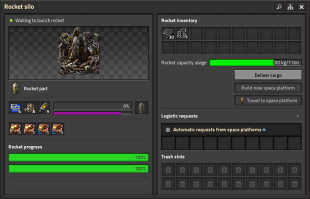
Rocket capacity
Unlike in the base game, a space age rocket can accept nearly every item in the game as a payload. This is expressed by the silo as a weight limit. Every item in the game has a rocket capacity which is the maximum number of items that can fit in a single rocket. An item's rocket capacity can be read by the circuit network by feeding an item into the selector combinator and choosing the respective mode of operation. As a general rule of thumb, the more complex the item, the fewer can fit within a rocket.
Some items, like the rocket silo itself and the atomic bomb, are too heavy for rockets, and so the raw materials must be shipped to orbit individually and assembled on the destination planet.
Fluids cannot be put in rockets, but full barrels can. Some fluids cannot be barreled, so they cannot be transported by rocket. This is notably the case for all the fluids that can only be obtained on Fulgora and Aquilo, except for fluoroketone.
Orbital requests
The rocket silo can detect requests from any space platform in orbit around the current planet. These can be satisfied in two ways.
- If "Automatic requests from space platforms" is not selected, the silo acts as a large container. Items can be inserted and removed with inserters. If the silo receives a full rocket of a single item that is requested, the rocket will automatically launch to the platform requesting that item, even if the payload is more than what is being requested. If multiple platforms are requesting the same item, the rocket will prioritize the earliest platform that the player created.
- If automatic requests is selected, the silo acts similar to a requester chest. Logistic robots will fill the silo automatically from the logistic network (including from buffer chests), and the rocket will launch automatically when full, unless the requesting platform has set a minimum payload to a lower amount than a full load. If there are items in the rocket inventory when this box is selected, those items will be moved to the silo's trash slots and be removed by logistics robots.
Regardless of option selected, the rocket will only launch automatically when it contains at least one item.
The silo can be connected to the circuit network, with two output functions.
- Output requests: Outputs the sum of requests from all orbiting platforms, if any. A request is considered satisfied and will be removed from the output the instant the rocket launch is triggered, not when the delivery to the platform actually happens.
- Output contents: Outputs the contents of the rocket silo. If automatic requests is selected, this option will do nothing.
Maximum throughput
In the base game, a fully moduled silo has +611% crafting speed from beacons and +40% productivity.
Modules accelerate crafting time in the first phase, but have no effect on animations in the other phases.
There are five phases to a rocket launch.
Working
Rocket parts must be assembled in the silo before the rocket can be deployed.
The best possible time to assemble 100 rocket parts, based on the rocket part recipe and the module effects, is 1250 ticks, or ~20.833 seconds.
1250 ticks elapsed.
Preparing rocket for launch
The rocket is brought up out of the silo so a payload can be inserted, if any.
This animation lasts 890 ticks, or ~14.833 seconds.
2140 ticks elapsed.
Waiting to launch rocket
The payload must be inserted.
One fast inserter arm swing to insert a Satellite is 14 ticks, or ~0.233 seconds.
2154 ticks elapsed.
Launching rocket
The rocket is launched with the payload. This phase ends when the result inventory appears inside the silo.
1162 ticks, or ~19.367 seconds.
3316 ticks elapsed.
Reset
The silo door must close before the cycle begins again.
368 ticks, or ~6.133 seconds.
If a second rocket was buffered within the silo, this step is skipped.
Conclusions
Grand Total: 3684 ticks, which gives a total cycle time of ~61.417 seconds, including time spent building rocket parts and inserting the payload.
With a build time of 1250 + 14, the delay from animations is 2420 ticks.[1]
Space Age
In Space Age, the rocket silo gained the ability to buffer a second rocket ready to load and launch [2]. If a second rocket is ready, then the rocket silo skips the door close/open animation. This results in a rocket launch approximately every 27 seconds, with sufficient speed and/or productivity bonuses (enough to get 111 rocket parts per minute).
Achievements
The rocket silo, which is used to win the base game, is directly connected to the following game-win-based achievements:

|
Smoke me a kipper, I'll be back for breakfast Launch a rocket to space. |

|
No time for chitchat Launch a rocket to space within 15 hours. |

|
There is no spoon Launch a rocket to space within 8 hours. |

|
Raining bullets Launch a rocket to space without building any laser turrets. |

|
Steam all the way Launch a rocket to space without building any solar panels. |

|
Logistic network embargo Finish research with space science pack for the base game or any planetary science pack for Space Age |

|
So long and thanks for all the fish |
Trivia
Prior to version 2.0, the rocket could accept any item as cargo; however, most did nothing in particular and simply wasted the launch. Notable exceptions included:
Gallery
-
The victory screen
-
The rocket rising and being primed for launch.
-
The rocket launching.
-
The rocket silo's GUI
-
The rocket silo's GUI in Space Age
History
- 2.0.7:
- Updated sprite for the rocket. A payload is now required to win the game.
- Rocket silos continue producing parts for the next rocket while the current rocket is being launched. Completing another rocket soon enough skips closing and reopening the doors.
 Rocket silo circuit connection can read orbital requests.
Rocket silo circuit connection can read orbital requests.
- 0.17.0:
- Updated sprite and changed dimensions from 9×10 to 9×9. A satellite is no longer required to win the game.
- 0.13.9:
- Rocket parts from building rockets in the silo now show in production statistics.
- 0.12.7:
- Updated icon.
- 0.12.4:
- Rocket silo now behaves correctly when out of electricity.
- 0.12.0:
- Introduced
